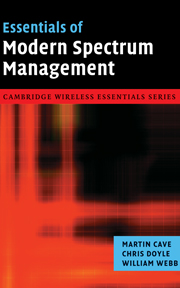Book contents
- Frontmatter
- Contents
- Acknowledgements
- I Emerging problems with the current spectrum management approach
- 1 Current spectrum management methods and their shortcomings
- 2 How changing technology is impacting spectrum management
- 3 Alternative ways of dividing spectrum
- II Markets
- III Regulation
- IV Conclusions
- Further reading
- Abbreviations
- Author biographies
- Subject index
3 - Alternative ways of dividing spectrum
Published online by Cambridge University Press: 13 August 2009
- Frontmatter
- Contents
- Acknowledgements
- I Emerging problems with the current spectrum management approach
- 1 Current spectrum management methods and their shortcomings
- 2 How changing technology is impacting spectrum management
- 3 Alternative ways of dividing spectrum
- II Markets
- III Regulation
- IV Conclusions
- Further reading
- Abbreviations
- Author biographies
- Subject index
Summary
Spectrum has been divided by frequency
In this chapter we look in more detail at different mechanisms for dividing up access to the spectrum. The previous chapter noted that spectrum is typically divided by frequency, with each user being given exclusive access to a frequency. In this chapter we look at the current process in more detail, assess all the different mechanisms for dividing spectrum and look at the impact that a change would have on the current use of radio spectrum.
Before delving deeper into spectrum access it is worth considering the question of what spectrum actually is. When a user gains a licence they do not actually gain any “spectrum”. Indeed, there is not really any such thing as radio spectrum, it is merely a representation of electro-magnetic radiation. Instead, users typically get a licence to transmit at a specific frequency and often with other conditions attached. Implicit to this is the expectation that they will be able to receive the transmitted signal without any harmful interference. We return to look at these conditions or “rights” in more detail in Chapters 7 and 8 where they become an important component of spectrum trading. As long as these rights are not compromised, other users could in principle access the same frequencies. Any method of dividing access to the spectrum that allows users to receive their transmitted signal would be viable.
- Type
- Chapter
- Information
- Essentials of Modern Spectrum Management , pp. 25 - 34Publisher: Cambridge University PressPrint publication year: 2007



